#Ivan Turina
Photo
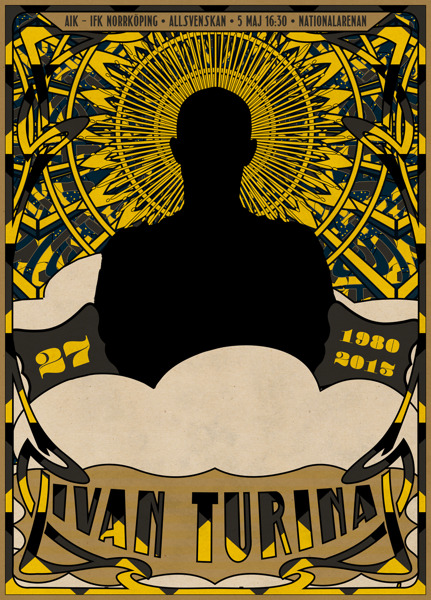
AIK – IFK Norrköping (Allsvenskan Herr 2024)
AV Christopher Anderton
0 notes
Text
May 2, 2013
TURINA
Ivan Turina was a Croatian footballer who played at both professional and international levels as a goalkeeper. On 2 May 2013 he died in sleep in his apartment in Solna. His wife didn't realize what had happened until the morning. The autopsy report released on 10 July 2013 states that Turina's death was caused by cardiac dysrhythmia - a congenital heart defect.
2 notes
·
View notes
Photo

VM Final Ivan Turina is Trending on Saturday July 14 2018 https://www.aioinstagram.com/vm-final-ivan-turina-is-trending-on-saturday-july-14-2018/
Expressen says: VM-hjälten spelar finalen för Turina Aftonbladet says: Modric om Turina: ”Har gått igenom mycket med Ivan”
Top 2 articles about VM Final:
På Kroatiens presskonferens, en dag innan VM–finalen, frågar SVT:s reporter David Fjäll om Modrics relation till Turina. – Jag har gått igenom mycket med Ivan Turina, inte minst i Dinamo Zagreb. Vi skulle ägna en seger åt inte bara Ivan, utan alla i
På söndag möts Frankrike och Kroatien i VM–final. Vid kroatisk seger kommer superstjärnan Luka Modric ägna en extra tanke åt bortgångne vännen Ivan Turina. – Jag har gått igenom mycket med Ivan Turina, säger han på dagens presskonferens, enligtnbsp;…
0 notes
Text
U Dubravi otkriven mural posvećen Ivanu Turini
U Dubravi otkriven mural posvećen Ivanu Turini
[ad_1]
Prošlo je točno šest godina otkako nas je napustio Ivan Turina. Nesretnog 2. svibnja 2013. godine stigla je vijest da je sjajni golman, još bolji čovjek preminuo u snu u 33. godini od zatajenja srca u svom stanu u Stockholmu.
Svake godine od tada 2. svibnja u Zagreb stižu navijači njegovog posljednjeg kluba, AIK-a.
Tako je i ove godine. Šveđani su doputovali u Zagreb, a u Turininom…
View On WordPress
0 notes
Text
“Ci siamo sentiti tanto vivi da credere di poter vivere per sempre”: il genio atrocemente precoce di Pasolini. Intervista a Ivan Crico
Di implacabile bellezza, una vertigine biblica. Avvicino I Turcs tal Friùl, dramma friulano di Pier Paolo Pasolini del 1944, pubblicato postumo nel 1976, meritoriamente edito, ora, da Quodlibet, ai testi biblici più possenti, gli atroci, Giobbe, Isaia, Kohelèt. Sottolineo certe frasi, di ulcerata meraviglia, tradotte con talento, in versi, dal poeta – e pittore – Ivan Crico. “La morte/ oggi ci attende in ogni dove. Qui/ intorno a noi, Cristo. Dove ci siamo/ sentiti tanto vivi da credere/ di poter vivere per sempre”; “Pregare e lavorare;/ non altro ci resta… come/ sempre siamo vissuti morire”; “quello che prima/ non capivo del Signore, adesso/ lo capisco: anche il più grande/ mistero, anche le cose più nascoste,/ anche la morte”. Vanno sottolineate queste frasi, teologia cruenta, ferocia estatica, cielo di creta, Dio con lingua d’argilla. Come si sa, Pasolini esordisce nell’alveo friulano, con le Poesie a Casarsa (1942) e lì muore (nel recupero, allucinato, delle “Poesie friulane” in La nuova gioventù, nel 1975), segno di una indifesa fedeltà alla giovinezza e a quella fiammata ispirazione. Sulla dignità della poesia in lingua ‘altra’ Pasolini edifica il suo primo sforzo critico – l’antologia sulla Poesia dialettale del Novecento, 1952 – con perizia poliedrica (il 31 luglio 1953 al giovane poeta veronese, e paraplegico, ‘Cesarino’ Padovani, Pasolini scrive, con cannibale dedizione, “La prosa della tua lettera mi piace assai di più dei tuoi versi dialettali, che, a parte una certa goffaggine e ingenuità infantile… rivelano la presenza di influenze, chiamiamole letterarie, non buone. C’è implicitamente, dietro le tue parole, l’opinione errata che il dialetto debba servire a trasporti affettivi convenzionali e senza mordente, conditi da un’obbligatoria intonazione comica. Cosa che avrà entusiasmato i nuovi veronesi di “musa triveneta”. Essi sono dei dilettanti e dei superficiali: magari simpatici come persone, ma molto impreparati e faciloni come letterati. Tu hai probabilmente le doti per metterli per una strada più seria”). In fondo, è grazie all’audacia critica di Pasolini se oggi riconosciamo in Franco Loi, Albino Pierro e Raffaello Baldini alcuni dei poeti grandi del secondo Novecento e in Pierluigi Cappello – che del me donzel di PPP è figlioccio – e Flavio Santi e Fabio Franzin e Isacco Turina, per dire di alcuni, i talentuosi di oggi. Dunque, è perfino necessario, ineludibile, il progetto editoriale costruito per Quodlibet da Giorgio Agamben, che in ‘Ardilut’ – araldica pasoliniana – pubblica testi in lingue altre, d’altrove, rintracciando nel multilinguismo l’origine stessa della letteratura italiana (“Era stato Dante a porre le origini della poesia italiana sotto il segno del bilinguismo…”). La curatela del testo di Pasolini, che si basa sulla storia – foriera di leggende e di canti popolari – dell’avanzata dei “Turchi” – cosiddetti, a indizio di sterminata ferocia – in Friuli, fino a Casarsa risparmiata, è impeccabile. Alla traduzione ‘di servizio’ di Graziella Chiarcossi, infatti, fa il paio quella in versi del poeta Ivan Crico, che esalta la forza del friuliano secondo Pasolini. Il testo, costruito assecondando la snervante attesa dell’invasore, secondo i lamenti degli abitanti – il crisma, appunto, che sta tra il coro della tragedia greca e quello delle Lamentazioni bibliche – ha abissi bianchi, “Ma, qui, in fondo a/ questi campi, tra quattro case/ grigie di fumo sperduti, in un buco/ del Friuli, come può il Signore/ ricordarsi di noi? Si nasce. Si vive./ Si muore. E non sa niente di noi./ Ci uccidono; e Lui non sa nulla”.
Come si colloca questo ‘atto sacro’ di Pasolini, che cosa è, da che storia arriva?
Il testo teatrale di Pasolini, un atto unico con un’impostazione frontale che si rifà al teatro misterico medievale (scritto a ventidue anni nel maggio del 1944 e pubblicato postumo nel 1976), si ispira ad un fatto reale: la tragica invasione del Friuli, nel settembre del 1499, da parte di truppe provenienti in gran parte dalla Bosnia e definite in modo generico, dalle cronache del tempo, “i Turchi”. Le incursioni, sempre rapidissime e violentissime, in realtà furono più d’una, distribuite nell’arco di quasi due secoli. Tutte, però, contraddistinte dalla medesima sistematica ferocia nel distruggere interi paesi, bruciandoli, uccidendo, violentando, imprigionando ragazzi e ragazze per poi rivenderli, come schiavi, nei marcati d’oriente. La scia insanguinata di terrore lasciata dietro di sé da questi terribili cavalieri continuò, fino alle soglie del nostro tempo, ad alimentare le paure dei friulani nei racconti nelle stalle, nelle osterie, ricomparendo perfino in certe cantilene infantili, nei modi di dire. Pasolini raccoglie memorie orali, studia le descrizioni delle stragi nei documenti dell’epoca, ma soprattutto rimane molto colpito da una lapide, conservata nella Chiesa di Santa Croce a Casarsa della Delizia, in cui alcuni paesani ricordano il “miracolo” che risparmiò il paese e la promessa di erigere l’edificio sacro in segno di ringraziamento alla Beata Vergine. Con tanto di nomi e cognomi che diventano i protagonisti del dramma pasoliniano. Il giovane poeta scrive di getto questo capolavoro in un frangente altrettanto drammatico: sotto i bombardamenti, la minaccia delle truppe naziste; e quel lontano episodio diventa un pretesto per parlare del ripetersi, nella storia, di questa voragine immensa – che annienta ogni certezza e tutto trascina nel suo fondo buio – che è la guerra.
C’è un senso del sacro, fin dalla preghiera iniziale, incessante, e una domanda di Dio tra chi non lo capisce (“Oggi noi / ci accorgiamo che molto più in alto / Tu sei della nostra pioggia e del sole/ e di tutti i nostri affanni. La morte / oggi ci attende ovunque”) e chi non capendo lo cerca. Insomma, si tratta di pensieri austeri, australi, che in italiano, probabilmente, rischiano di essere astratti rispetto al terreno dialettale.
In questo particolare caso, il rischio di distanziarsi troppo dal testo originale, in termini di astrazione, non è stata in realtà la principale preoccupazione perché il friulano impiegato da Pasolini, come è stato definito da una grande studiosa locale, Andreina Ciceri, amica del poeta e prima curatrice dell’opera, è un friulano estremamente letterario, con echi leopardiani e addirittura dannunziani, “reso classico, candido, assoluto dalla sapienza elettiva-selettiva e da qualche inserto arcaicizzante”. Una definizione perfetta per descrivere un linguaggio decantato, depurato, illimpidito come un diamante grezzo da una sapiente opera di politura. Il friulano scritto di Pasolini non è il linguaggio mimetico che ricercherà, qualche anno più tardi, frequentando le degradate borgate romane. Qui il friulano scritto sta a quello parlato come la lingua purissima, assoluta di Penna confrontata con la nostra lingua di ogni giorno. Con la differenza che il friulano, arcaica lingua romanza costellata da dolci palatalizzazioni, dittonghi, straordinari arcaismi, è comunque una lingua estremamente musicale, anche nel suo darsi più quotidiano ed umile, che Pasolini sapeva mettere in risalto e far ‘cantare’ come nessun altro era mai riuscito a fare prima di lui.
Che armi linguistiche hai adoperato, quindi, per tradurre in italiano questo Pasolini?
La preoccupazione di Agamben, quando mi ha proposto questo lavoro in forma poetica, era quella di tentare di riflettere in italiano una medesima, fluida, sospesa musicalità, che nella traduzione letterale spesso, in modo evidente, si perdeva quasi del tutto. Anche in una traduzione splendida, come quella approntata da Graziella Chiarcossi, che permette in ogni caso al lettore di farsi un’idea molto precisa del testo originale. Come procedere quindi? Nel testo pasoliniano vi sono due brevi intensissimi momenti lirici, i “cori dei Turchi”, che sono scritti in endecasillabi giambici, che ho proposto da subito di prendere a modello. Casualmente, proprio in quei giorni, la Valduga presentava a Pordenone la sua interessante traduzione per Einaudi delle poesie milanesi del Porta, caratterizzata da un uso sapiente dell’endecasillabo e della rima. Parlai delle mie impressioni di lettura con Agamben, che aveva già letto il testo, e convenimmo che non era un modello applicabile a questo lavoro: il rischio di creare delle forzature, obbligando un testo così lungo all’interno di una forma predeterminata, rendendolo poco scorrevole, era troppo grande. Così proposi di lavorare con versi liberi, ricercando una musicalità simile a quella dell’originale, a costo di invertire interi periodi, tenendo però sempre in mente una certa durata similare del verso che poi spesso, ma non sempre, in modo non predeterminato, coincideva con quella della metrica adottata nei “Cori”. Scrivendo, ho pensato anche ad alcuni ‘maestri di stile’ di Pasolini, da Pascoli a Penna a Caproni, con uso frequente, tipicamente pasoliniano, dell’enjambement ed un impiego, in modo sempre assai parco, della rima (a volte anche non immediatamente percepibile), sia interna o, a volte, anche molto distanziata.
…e la scelta, così particolare, di una traduzione in versi?
Si tratta, come avevo accennato, di un’intuizione di Agamben. Che mi è sembrata da subito, per quanto ardita e rischiosa, una strada interessante da percorrere, potendo anche contare sui suoi preziosi, sempre puntuali consigli. Poi, a traduzione quasi completata, mi sono imbattuto in questa osservazione di Andreina Ciceri che, all’improvviso, ha illuminato con una nuova luce tutta questa operazione: “Circa l’estrema affinità, in Lui, tra prosa e poesia, sono rivelatrici alcune pagine dei suoi manoscritti dove, alla redazione in prosa segue o si affianca lo stesso testo trasposto in ritmi e versi, con pochissimo scarto quantitativo”.
Un’altra novità di questa edizione è la revisione critica ed una nuova traduzione filologica dell’opera.
Sì. La cugina di Pasolini, la filologa Graziella Chiarcossi, ha portato avanti in questi anni un approfondito studio comparativo delle varie redazioni manoscritte de I Turcs tal Friul, apportando integrazioni e correzioni significative rispetto alle edizioni precedenti. Nel volume di Quodlibet è riportata anche una sua autorevole traduzione letterale del testo, fondamentale per aiutare il lettore interessato ad un confronto diretto con il testo originale in lingua friulana.
La poesia, qui, si muove tra dimensione teatrale, drammatica, e teologica, furibonda (“come può il Signore/ ricordarsi di noi?”), in una ricerca della verità che scortica (“La sera, quando rientro/ dai campi, in cima al carro colmo/ di fieno, mi sembra di toccarlo/ con le mani il Signore, nel cielo”). Da una parte, mi pare prefigurare l’opera intera, polimorfica, di Pasolini, dall’altra, in fondo, che la poesia non sia altro che questo. Dimmi.
In effetti, rileggendo a fondo questo testo esemplare, che lo stesso Pasolini considerava «forse la migliore cosa che io abbia scritto in friulano», ci si rende conto che, in nuce, qui già troviamo molti temi con cui il poeta tornerà a confrontarsi per il resto della sua vita. Qui, all’incrollabile (sincera oppure di facciata) fede popolare che anima alcuni protagonisti della vicenda si contrappone, sempre, il dubbio, che spesso sfocia nell’imprecazione, nella bestemmia. Bestemmia che però è anch’essa alla fine un atto, forse ancor più forte e cosciente, di fede e speranza di poter cambiare – magari a costo della propria vita – il corso delle cose. Presentando questa edizione, il curatore della collana ci ricorda che “Sotto l’apparenza di un’evocazione storica, è tutto il mondo di Pasolini che I Turchi in Friuli mette in scena in un inestricabile ordito di elementi personali (i protagonisti portano lo stesso nome della madre Susanna Colussi) e motivi ideali: l’appassionata fede religiosa e la rivolta contro la Chiesa, l’amore per la vita e la fascinazione per la morte (l’uccisione di Meni Colùs alla fine del dramma sembra annunciare quella del fratello Guido solo un anno dopo), l’impegno nell’azione e la fuga nella preghiera. E non è certo un caso se tutti questi motivi, almeno in apparenza contraddittori, si compongono in una parola che è la stessa che il poeta molti anni dopo avrebbe proposto come titolo per la raccolta delle sue poesie complete: bestemmia”.
*In copertina: Pier Paolo Pasolini e Italo Calvino, scatto tratto dalla mostra fotografica “Poeti a Roma”.
L'articolo “Ci siamo sentiti tanto vivi da credere di poter vivere per sempre”: il genio atrocemente precoce di Pasolini. Intervista a Ivan Crico proviene da Pangea.
from pangea.news http://bit.ly/2GP2TiA
0 notes
Video
youtube
Há pouco mais de 1 ano, Ivan Turina nos deixou. O que nos resta é relembrar a belíssima e merecida homenagem que a torcida do AIK fez para o goleiro croata, que é um dos maiores ídolos da história do clube.
0 notes
Photo
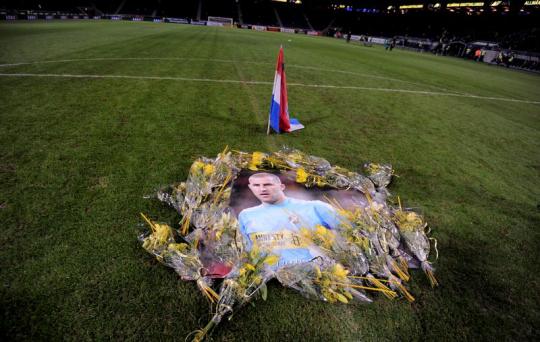

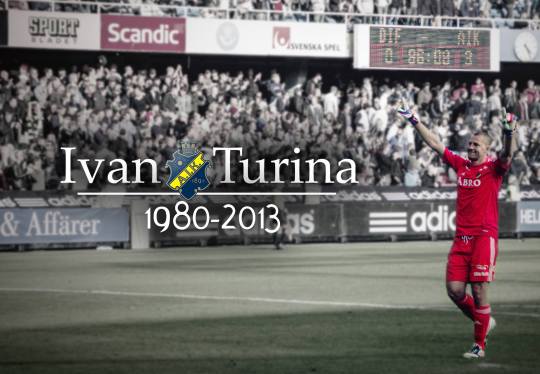
Remembering Ivan Turina: One Year Later
Exactly one year ago, our football family suffered a great loss with the untimely passing of Ivan Turina, former AIK goalkeeper, but more importantly, a hero and friend to his local community. Last year, our friend Özgür Kurtoglu wrote a piece on what Ivan Turina meant to him personally. Exactly one year later, here's Özgür looking at how a heavy weight still remains over Stockholm.
There’s a bronze statue in Miroševac, a torso placed upon a square of what looks like limestone, but it's a figure not easily distinguishable via a solitary photograph shared on Facebook for someone without a trained eye for that sort of thing. It stands in the corner of a slightly larger than normal burial plot, next to a bench for visitors to rest upon, and a meter or two away from the cold black stone of a grave adorned with a flower arrangement, a scarf and a bottle of Coca-Cola. Another bottle remains placed inside the Friends Arena in Stockholm, within a now unused and semi-vacant booth in the locker room of AIK, in front of a Croatian flag. It will probably never be entirely vacant, in all honesty, but it does stay unused, even though it is still clearly occupied by the presence and the massive absence of Ivan Turina.
It’s May 1st, and Kyriakos "Kenny" Stamatopoulos is at Ärvinge Idrottsplats in the northern Stockholm suburb of Kista. He is there with teammate and Costa Rican international Celso Borges, and they’re watching AIK striker and local hero Henok Goitom coach his own team, Kista Galaxy. I know this because my younger brother knows this, because he plays for that team and keeps his years spent in AIK youth teams and the relationship to the club born out of it alive in the Swedish 4th Division, playing for a team founded by an AIK supporter and player. I ran into Kenny at the AIK club shop a month or two ago, while I was working on the #dresscodeblack campaign tied to the new kit release for the upcoming season. He was there to get some jerseys personalised, for friends and family and his kids, and was basically just as laid-back and easygoing as his dear friend and goalkeeping colleague had been known to be pretty much all the time outside of the stadium. He is also someone who has talked about having to leave the room whenever his wife speaks to Senka Turina on the phone, because the knowledge of her loss becomes too unbearable for him to cope with, still. He’s spoken about being ushered into a role at AIK that he never wished to have to deal with in this way.
Kyriakos Stamatopoulous, called Kenny by some and Stam by others, is our first choice keeper now. He always challenged Ivan for the starting spot in goal when they played together, and now he’s a given in goal while goalkeeping coach Lee Baxter works with his 22 year old future replacement, Patrik Carlgren, prepping him for a future where Kenny is no longer able to play. The season has started like all AIK seasons start: other champion candidates lock in their gameplan and run through matches like it’s nothing, while AIK slides behind desperately trying to make things work: champions Malmö FF are 1st, grabbing 16 points out of a possible 18, while AIK are 9th with a measly 8. Things will hopefully click sooner rather than later; AIK will hopefully start playing the football the entire country suspects they can, and perhaps the predictions of a title challenge will come to fruition.
But there’s a hole there, constantly. Friends Arena still feels wrong, and it isn’t getting better; a new turf was installed a week before the opening match of the season, and has now fallen apart and been replaced. Since the arena holds 55000 spectators, AIK asked for heavy-duty curtains to seal off the upper tier when the previous season ended in November, and the company running the stadium started looking for options in mid-March. The drainage system is broken and floods the pitch during medium rain, the ventilation is non-functional and does nothing when a single flare is lit inside the arena, and before the opening match of the season on March 31st, the garbage left from the national bandy final played at Friends Arena on March 16th was still there. Even the AIK players' booth was coated with dust left to gather and sit for six months, without anyone responsible for it to be cleaned doing anything. Friends Arena is comfortable and shiny and has all the features foolishly expected from a modern football stadium, but is utterly horrible for football, so we all collectively miss our real home: Råsunda. Something which just reminds us of losing our home. Which just reminds us of our losing our Ivan. Add these feelings up, and a wonderful spring day in Stockholm, like May 2nd, feels miserable. All of it just feels wrong: the pathetic excuse of a football stadium we’ve been forced to play in, the vast emptiness looming over where Råsunda once hosted AIK and Pelé and thousands upon thousands of wonderful football players, the gutwrenching hollowness of remembering Ivan, and May 2nd is just a horrifying torrent of memories that ultimately haunt us and hang over our hearts like daggers.
There’s a bronze statue in Miroševac, a statue of a giant. A statue of a leader, a father, a friend, a husband. A statue of a proverbial wall, a mighty last defence, a guardian rarely seen in black and yellow but the penultimate defender of those very colours. There’s a bronze statue in Miroševac of Ivan Turina, keeper gloves neatly tucked in under his left arm, standing next to his grave. He is no longer keeping our goal in Stockholm, and watching AIK warm up before matches and remembering why Ivan isn’t there, goofing around with Kenny and Lee Baxter, is still mind-numbingly painful. But, exactly one year after I broke down in tears on the subway on my way to work, I know now that I don’t think I want you back here among us AIK faithful. I don’t, because I’d rather see you retire your #27 jersey immediately if it meant you’d get a chance to hold your son for the very first time, to hold your wife and your daughters again. I’d gladly accept you leaving AIK if it meant not seeing little Bruno next to your statue, next to your grave, rather than in your arms.
I miss Ivan Turina. AIK misses Ivan Turina, both the goalkeeper and the giant of a human being. But I’d give up my wonderful memories of him playing for the club I love if it meant he’d be running around right now, running after his son and his daughters on a sun drenched field somewhere in Zagreb, maybe in their summer house on Murter with his best friend Jerko Leko and his family, with his wife watching them all, smiling, laughing. I wouldn’t hesitate for a second.
This was a guest article by Özgür Kurtoglu, a member of the AFR family. Additionally, photographs come courtesy of Jesper Zerman, Annika Berglund and AIK. You can follow Özgür on Twitter at @BordeauxBlues. Comments below please.
168 notes
·
View notes
Photo

Info: AIK – IFK Göteborg (Allsvenskan AIK Fotboll Herr 2022)
Av: Christopher Anderton
Mer info:
0 notes
Photo

RIP Ivan Turina
37 notes
·
View notes
Photo

Ivan Turina AIK:s fina hyllning på Ivan Turinas årsdag is Trending on Wednesday May 2 2018 https://www.aioinstagram.com/ivan-turina-aiks-fina-hyllning-pa-ivan-turinas-arsdag-is-trending-on-wednesday-may-2-2018/
Expressen says: AIK:s fina hyllning på Ivan Turinas årsdag Fotbollskanalen says: TV: Se AIK-fansens hyllning till Ivan Turina
Top 2 articles about Ivan Turina:
Bland spelarna fanns den förre AIK-spelaren Bojan Djordjic, som var lagkamrat med Ivan Turina under hans år i AIK. – Det har varit känsloladdat. Jag har varit här några timmar innan laget kom hit eftersom att man vill få sin egna lilla tid. Där hans
Ivan Turina avled i dag för fem år sedan. Då hyllades minnet av honom av AIK-fansen mot Sirius. – Det är vackert, säger C Mores kommentator Patrik Westberg. Facebook Twitter. Den tidigare AIK-målvakten Ivan Turina gick tragiskt bort i dag för fem år
0 notes
Text
AIK goalkeeper Ivan Turina found dead in his apartment
May 2, 2013 14:08 IST
The 32-year-old Croatian signed for AIK in 2010 and played 65 league games for the Solna club.
Swedish football club AIK's Croatian goalkeeper Ivan Turina has been found dead in his northern Stockholm apartment, according to local media reports on Thursday.
"I can confirm that Ivan Turina is dead but there are no suspicions of crime," police spokesman Patrik Nuss was quoted as saying by the Aftonbladet newspaper. Police said they were called to Turina's apartment early on Thursday morning.
The 32-year-old Croatian signed for AIK in 2010 and played 65 league games for the Solna club. He is survived by his wife and two one-year-old daughters.
SOURCE: dnaindia.com
0 notes
Photo










Tomhet, Idel Tomhet: Remembering Ivan Turina
We tend to have a habit of talking about a 'football family;' a sort of community of fans, journalists, players and coaches who all interact to make our small corner of the world possible. Though we may bicker over rivalries, and obsess over insignificant rumors, we are all nevertheless interconnected. Our successes and moments of joy are shared, just as those moments of pain. This past week, the football family suffered a great loss with the sudden death of AIK goalkeeper, Ivan Turina. Here's Özgür Kurtoglu, remembering Ivan.
The dots representing events in my life are connected by football matches, concerts and records. These subjects, the type of stories that I know I shouldn't write about, but feel the need to write, are not meant to be written or told or even reiterated by someone like me. I am but a music journalist, a hopeless romantic, savvy of the way things are, but in love with how they were in a pre-digital age; a devotee easily swayed by my ever-welling emotions and unwavering naïveté. I am too much of a fan to write about football; I learned and was taught that fact the hard way as early as the somewhat innocent age of 17. Every now and then I try, as soberly as I can, to peek inside my private and forgivingly small part within this circus that a woman I once loved called my second great love (her, supposedly, being the first), before I shy away cautiously so I don't end up too deep.
I write about music. I've known music and played music for the better part of the last 18 years, and while my relationship with the arts and crafts is just as irrational as my feelings for football, my view of music can at times be far more pragmatic; I can distance myself from it, I can shut it out and shut it off, and despite it being my job, I can still escape from it. Football lives too far under my skin. The teams I support, that I've supported for the better part of my soon to be 24 years on this weird little watery rock, are pins and needles in my veins and in my bloodstream. So I let them fill out my calendar with their matches while I "toil" at shows and clubs where I spin records, or record stores where I may roam, and every now and then try to assemble a proper picture of what my life actually is;
Our last championship was preceded by a week of listening to the new Girl Talk record and followed by the second-to-last ISIS show I saw before the band broke up. I fell in love outside of Råsunda, my second home for 15 years, right before a game that started off that horrendous 2010 season that eventually brought us Ivan Turina, and spent the week after it at Stockholm University studying film music and popular culture. I was updated via Twitter on how that very man pulled off what is basically, after this decent effort from our Assistant Manager in the Champions League eons ago, the best performance ever to be put on display in an AIK shirt. After CSKA buried us easily at Råsunda in the first leg, I chose to see the fantastic Soundtrack Of Our Lives for the very last time at one end of Stockholm and then trudged my way, somewhat reluctantly, to see the pop disaster that is Coldplay at the other end, because just like everyone else, I knew this draw to be over. Ivan Turina thought and believed otherwise, and made sure every AIK player knew what he was trying to do. And he succeeded.
Ivan Turina is 32 years old. And he will always be 32 years old. On April 28th, when AIK finally managed to break our scoring deadlock at our new and somewhat unwanted stadium, and managed to turn an absolutely ridiculous game-winning goal into another draw, I ended up stuck in a stairwell for 15 minutes because of a malfunctioning emergency exit before making my way back up to the second tier to find a way out. That was the last time I saw Ivan Turina, out of the game because of a back injury and carrying his two daughters while dressed handsomely, impeccably, in a gray suit.
I saw him for 15 seconds at most, too busy being frustrated and annoyed to greet this behemoth of a man and his beautiful family, and immediately regretted it as soon as I got out of the stadium. Not because I had any inclination of what was about to happen, but because of basic courtesy; a football club is a family, at the best of times, but more so in the worst of times. This Thursday, on my way to pick up this month's issue of the music magazine I work for to have it distributed around Stockholm, I received a text message. Then some Facebook notifications that were immediately followed by tweets and phone calls, all telling me something I still fail to grasp. Something that my mind still doesn't quite comprehend, that it still tricks me into believing that I'm imagining it all. But it was all there in the newspaper.
I could quote poets and laureates, lyricists and authors of the utmost and heartfelt vociferations ever put on paper by pen, to attempt to do the memory of Ivan Turina justice, but to what end? He became part of our family by being the commanding leader that he so naturally was, steadfast and intimidating, stationed at the very back of a football pitch guarding the keep of ten men dressed in black. I write for a living, but I know when my words and my tools fail me; I know when other actions and other expressions ring truer and louder than my words ever could. Ivan Turina was one of us, is one of us, and he became the beloved man he is on the green fields. His homage was sent out into the skies from our new home yesterday. It is only right that you see it as I experienced and took part in it; that you see it as we hope Ivan saw it.
So what more could I possibly say? As insanely hateful as it might sound, and I mean this wholeheartedly, I don't want you to rest in peace, Ivan, because I want you to keep attempting insane volleys in the 93rd minute in an attempt to score against IFK Göteborg; I want you to look up to the flares and the inferno enveloping Norra Stå with an almost juvenile glee smeared across your face while the referee ushers in the rest of the players back into the tunnel, and you're just nonchalantly walking out into the smoke to jog and enjoy the chaos we've created, that you've grown up inside at Maksimir.
I can't sit there game after game wondering why you're not out on the pitch warming up before remembering that you can't, you won't, ever again. I want you to stop because we all know that the fact that a Swedish journalist, who is both a football lover and a dear acquaintance, pointed out that its underlying sentiment does nothing but hurt all of us now: you were born to play for us, to keep our goal, to command the defense, to be loved by us for longer than we were allowed to be blessed by your immense friendship.
I want you to play until your knees give in and your back hinders you from lunging towards the ball, Ivan. I want you to die an old man. I want you here, because you were one of us long before you even knew we, AIK, existed. I want you here, because you were supposed to walk among us for longer than this.
Footnote: The Ivan Turina Charity Game, promoted by footballing friends (Daniel Majstorovic (AIK), Luka Modric (Real Madrid), Ognjen Vukojevic (Spartak Moskva), Zlatan Ibrahimovic (PSG), Dejan Lovren (Olympique Lyonnais), Vedran Corluka (Lokomotiv Moskva), Eduardo Da Silva (Shakhtar Donetsk), Mario Mandzukic (Bayern München), of Ivan Turina, will be played between AIK and Dinamo Zagreb, Ivan's first professional club, at Friends Arena in Stockholm on May 13th 18:30 GMT+1. All proceeds will go the surviving family of Ivan Turina. Click here more information.
184 notes
·
View notes
Photo
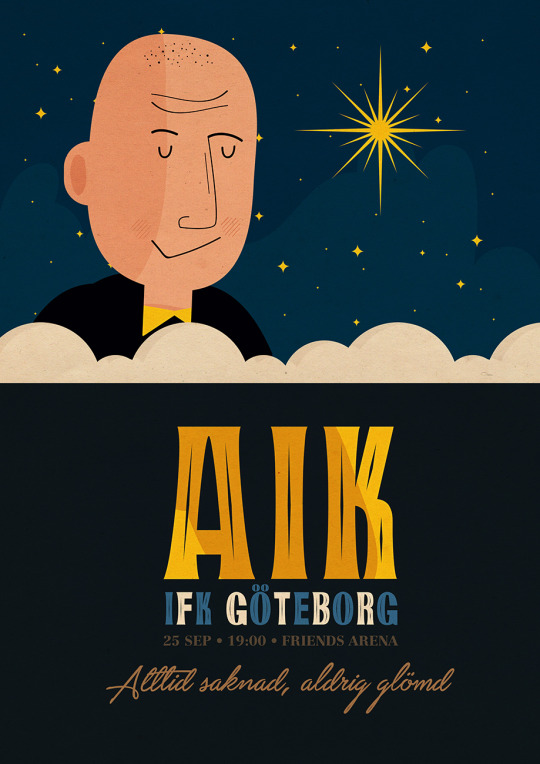
AIK-IFK Göteborg 2019.
Info: AIK-Blåvitt. Ivan Turina, alltid saknad, aldrig glömd.
Av: Christopher Anderton
Finns i storlekarna A3, 50x70cm, 70x100cm.
Köpinfo: https://chanderton.tumblr.com/information
0 notes
Text
Lovely to see #Modric playing with a black armband today in memory of his friend Ivan Turina. Mondays AIK game will be an emotional one.
— Samuel Hart (@FRfotbollSam) May 4, 2013
3 notes
·
View notes
Text
Улыбчивый гигант
Иван Турина был отличным вратарём и ещё более хорошим человеком. Он никогда и никого не оставлял равнодушным. Именно поэтому его оплакивает вся футбольная Швеция. Жизнь чемпионата Швеции стала намного беднее без гиганта из Загреба.

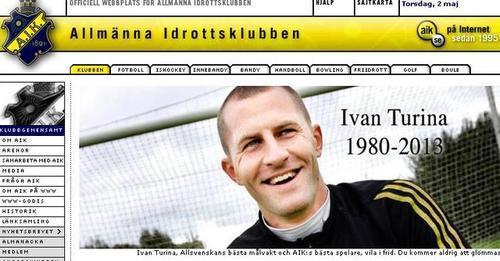
Я говорил с Иваном всего за пару дней до его смерти. У него были хорошие новости.
“Будущие топ-модели Тиа и Тара скоро получат братика или сестричку. Если у меня будет сын, то, возможно, это будет новый Златан!” - сказал Турина и засмеялся своим фирменным смехом.
В этом был весь он. Двухметровый гигант с сердитым лицом и бритой головой, но мягкий, как плюшевый мишка. У него всегда в запасе была шутка.
Первый раз мне довелось пообщаться с ним в 2010 году, когда он только перешёл в АИК. Эта сделка обещала быть одной из лучших в истории клуба. Сейчас я смею утверждать, что она была одной из лучших в истории нашего чемпионата. Долгосрочный контракт он подписал без колебаний.
То интервью я брал у него на пару с его другом и бывшим форвардом АИК Гораном Любоевичем. Я сразу отметил у Турины три вещи:
1. Его доброту;
2. Его хриплый, низкий голос;
3. Его железное рукопожатие. Это было всё равно, что опустить руку в лапу медведя.
Турина скромно говорил, что хочет стать основным вратарём “крысят”. Он быстро перерос роль ключевого игрока в клубе, став одним из лучших футболистов чемпионата. В то же время, он не отказывался от роли наставника для молодых Кваме Карикари и Мохаммеда Бангуры.
Турина был профессионалом до кончиков пальцев, предъявляя высокие требования не только к себе, но и к партнёрам. Он хорошо знал, когда есть место и время для шуток, а когда нужно серьёзно поработать. Благодаря этому профессионализму ему довелось поиграть с такими мастерами, как Роберт Левандовски и Лука Модрич. Но не как отличного вратаря я запомню его. Я запомню его отличным человеком. С большим, как футбольное поле, сердцем.
Иногда я мог позвонить ему, а он говорил, что сидит и ужинает с Модричем в Загребе. Иногда он мог сидеть в кафе l’angolo в Стокгольме и травить анекдоты. На фотографиях, оставшихся у меня, он стоит со Златаном Ибрагимовичем, с которым познакомился через общего друга Даниэля Майстровича. Иван был социальным гением. У многих с ним были особые отношения. Мы могли часами говорить о футболе, и в его присутствии невозможно было оставаться только профессионалом.
Вчера утром (2 мая - Прим.) я не хотел верить в то, что это правда, в то, что Иван мёртв. Писать о горе трудно, но ещё сложнее с ним смириться.
Мои мысли сейчас прежде всего обращены к его семье - беременной жене Сенке и дочкам-близняшкам. Однако на фоне общей скорби я бы хотел отметить - хотя все наверняка увидели - и одну прекрасную вещь, которая произошла в нашем футболе. Вчера мы объединились. Клубные цвета в этот день не имели никакого значения. Особенно этот факт подчёркивается тем, что на базе АИК лежат много шарфов “Юргордена” (принципиальнейший соперник для АИК - Прим.) среди моря цветов и чёрно-жёлтой атрибутики АИК.
2 мая 2013 года я всю жизнь буду вспоминать с грустью. Но я также буду помнить, что шведский футбол показал себя в этот день с лучшей стороны. Это заставило меня гордиться.
Текст: Даниэль Кристоферссон, шведская газета Expressen.
http://www.tv4play.se/program/fotbollsklipp?video_id=2346978
2 notes
·
View notes
